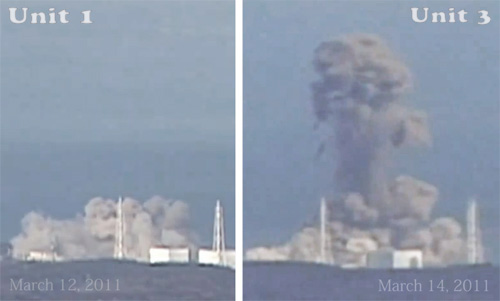Elaborating on a comment to that post, this essay will point out that exhaust stack elevation could have made a crucial difference in the Fukushima reactor accidents.
Electric motor-driven fans support just about every air handling system in the reactor building of a nuclear power station (see the numerous blower symbols in Fig. 1 from Row, 1971), pumping effluent gases to the main exhaust stack and maintaining a negative building pressure that disallows potentially contaminated air to escape unfiltered into the environment. Contaminated effluents are forced through filters and vented through the main exhaust stacks, except for hardened venting. During hardened venting, contaminated steam and gases may directly be routed to the exhaust stacks as a means of last resort in an emergency, relieving pressure from the reactor after all other options have been exhausted. Furthermore, hardened venting may prevent hydrogen produced by melting fuel rod cladding and radiolysis from reaching explosive concentrations.
Bird's eye view of Fukushima Daiichi Nuclear Power Station after hydrogen explosions destroyed the service floors of units 1 (left), 3 and 4. The tall exhaust stack towers can be seen on the left between units 1 and 2 and at center between units 3 and 4. The small sheds housing the fan gear are located at the base of the towers (source: cyptome.org).
But, the tall exhaust stacks at Fukushima need fan-support to generate sufficient draft. The fan gear is housed in small shed at their base. During a station blackout, the stacks must rely on draft alone.
According to the Fukushima Nuclear Accident Report (Interim Report) Dec. 2, 2011, of the stricken power station's operator Tokyo Electric Power Company (TEPCO), hardened venting released hydrogen in Unit 1's reactor building, flowing back through open valves and baffles. When mixed with air at concentrations above four percent, hydrogen may explosively deflagrate and detonate. At Unit 3, the hydrogen may have exploded inside the primary containment vessel.
 |
| Explosion at units 1 and 4 (courtesy: Goddard's Journal). |
 |
| Junction of SGTS effluent piping of Unit 3 and Unit 4 at the base of shared stack (arrow) (source: TEPCO). |
 |
| Unit 4's SGTS filter contamination. The connection to the stack shared with Unit 3 is on the right (source: TEPCO). |
Had the shared exhaust stacks been tall enough to passively generate sufficient draft, the hydrogen explosions may have been prevented, particularly the one at Unit 4. Therefore, it is prudent to ensure that all nuclear power stations are outfitted with exhaust stacks tall enough to provide sufficient draft when all power fails.
Tomorrow, Nov. 21, 2013, the US Senate Committee on Environment and Public Works and the Subcommittee on Clean Air and Nuclear Safety will hold a joint hearing on the "NRC's Implementation of the Fukushima Near-Term Task Force Recommendations and other Actions to Enhance and Maintain Nuclear Safety."
Hopefully, the NRC has incorporated sufficient exhaust stack elevation into its recommendations for US reactor operators.
Reference
- Row TH (1973) Radioactive waste systems and radioactive effluents. Georgia Institute of Technology Short Course.
SimpyInfo.org provided the information for this post.


Higher stack wouldn't help here. A shorter, wider stack would have actually been better. (Though worse for the workers on site.)
ReplyDeleteIt's venting light gasses from a pressurised container, with no natural draught required or used at all. (There is no convection, nor intake of fresh air at the base of the stack.)
Hydrogen does not generate a big draft in a stack like thermal convection because of its high diffusion speed. This results in hydrogen outflow not causing a significant lower pressure that could accelerate venting.
ReplyDeleteSo, the thoughput is mainly driven by diffusion, that is a function of the cross-section. Hence the only thing that helps is increasing the smallest cross-section of the whole system. If that is the stack is not clear. Could also be some other tubing or even the filters...
Thanks for your insightful comments. My hypothesis was that an improved draft in the tall stacks might passively increase the volume of air pulled through the reactor buildings’ HVAC systems up to the level otherwise maintained with power-driven fans and blowers, enhancing the rate of hydrogen diffusion and elimination from the buildings.
ReplyDeleteI agree Peter. A higher air change rate for the whole building driven by natural convection would in deed help. Not because hydrogen is transported quicker but because the hydrogen-air mixture would be kept at a better - ideally non-inflammable - ratio.
ReplyDeleteI think for the technical aspects a look to the old Zeppelin airships might be helpful. They also used internal stacks in the gas management system to prevent inflammable gas mixtures. The technology was already quite advanced in those old days. However there were still actidents (most famous: the Hindenburg) that showed that even these well designed venting systems could fail.
The underlying issue is that however you design a gas management system - as long as you keep potentially inflammable gas mixtures within a closed room for a while there is the risk of a katastrophic event.
Too true and Count Zeppelin was aware of the potential risk. My father told me the Count had originally used helium in his dirigibles. However, because the allies had imposed an embargo on helium after WWI, he resorted to hydrogen instead with the known catastrophic consequences. My father concluded had it not been for the Kaiser's war, we might be traveling in dirigibles across the Atlantic today, :).
ReplyDeleteI read your blog. Its simply superb. useful for PVC Pipes & Fittings Manufacturer Thanks for sharing
ReplyDeletePlastic Pipe Exporters